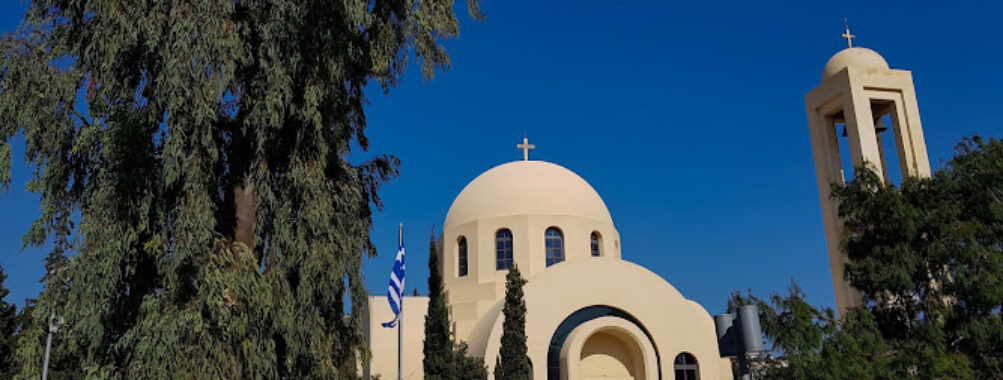
Panagia Faneromeni church
Table of Contents
Description
Panagia Faneromeni Church stands as a remarkable piece of Greek Orthodox heritage, offering travelers a glimpse into a blend of spiritual reverence and artistic finesse. This church, dating back to the 15th century, is not your typical tourist stop where you just snap a photo and dash off. Nope, it invites you to slow down, soak in its atmosphere, and maybe even reflect a bit. The architecture is a fascinating mix influenced heavily by Renaissance art, which you might not expect in a Greek Orthodox setting, but that’s exactly what makes it so intriguing.
Walking inside, you’ll notice it’s a single-aisle basilica without a dome, which is a bit unusual and gives the interior a unique vibe. The wooden roof, crafted with great care, adds warmth and character. The floors are parquet, which adds a touch of elegance without feeling pretentious. But the real eye-catchers are the icons and frescoes—especially the silver-plated icon of the Virgin Mary, which locals hold in high regard. These artworks aren’t just decorative; they tell stories, hold centuries of faith, and connect you to the past in a way that’s hard to describe.
One of the lesser-known tidbits about Panagia Faneromeni is that beneath its stone walls, archaeologists found traces of older masonry, suggesting the site was sacred long before the current church was built. So, you’re literally standing on layers of history when you visit. And if you’re someone who appreciates a bit of legend with your sightseeing, the story of the icon’s discovery adds a mystical charm that locals love sharing.
Accessibility is thoughtfully handled here, too. The church offers wheelchair-accessible entrances and parking, making it easier for many travelers to experience its beauty firsthand. It’s refreshing to see such care for inclusivity in a historical site.
Key Features
- 15th-century construction showcasing Renaissance artistic influences
- Single-aisle basilica design with a unique wooden roof
- Parquet flooring adding subtle elegance
- Impressive silver-plated icon of the Virgin Mary and other large frescoes
- Historical layers beneath the church hinting at earlier Christian worship
- Wheelchair-accessible entrance and parking facilities
- Located in a scenic district close to the southern side of Zakynthos city
- Rich local legends and spiritual significance enhancing the visitor experience
Best Time to Visit
Honestly, the best time to visit Panagia Faneromeni Church depends a bit on what you’re after. If you hate crowds and want a more contemplative experience, aim for the shoulder seasons—late spring or early autumn. The weather is pleasant, not too hot, and you’ll likely have the place more to yourself. Summer, of course, draws a crowd, especially since Zakynthos is a popular island destination, but the vibrant atmosphere can be quite energizing if you don’t mind sharing the space.
Visiting during religious holidays or feast days can be quite special, too. The church comes alive with local traditions, processions, and a palpable sense of community. That said, if you’re not into crowds or noise, maybe steer clear during those times. Early mornings are also golden hours to visit—soft light filtering through the windows makes the frescoes and icons even more magical.
How to Get There
Getting to Panagia Faneromeni Church is pretty straightforward, especially if you’re already on Zakynthos. It’s situated on the southern side of Zakynthos city in the Ammos district, which is easy to reach by car or taxi. If you’re feeling adventurous and want to soak in the local vibe, consider renting a scooter or bicycle—just be mindful of the island roads!
Public transport options exist but can be a bit hit-or-miss, so if you’re on a tight schedule, a taxi or rental car might be your best bet. Parking is available and accessible, which is a relief for those who’ve wrestled with finding spots near popular sites before. Once there, the church is easy to spot with its bright white walls and charming presence right near the shore path to Nea Skioni.
Tips for Visiting
Here’s where I get a little personal. When I first visited Panagia Faneromeni, I didn’t realize how much time I’d want to spend just sitting quietly inside, watching the light play on the frescoes and feeling the calm wash over me. So, my first tip: don’t rush. Give yourself at least an hour to really take it in.
Dress modestly out of respect—this is a place of worship after all. Even if you’re not religious, it’s just good manners and helps you blend in with locals who come to pray. Also, try to visit on a weekday if you can; weekends tend to get busier with tourists and churchgoers alike.
Photography is usually allowed but keep your flash off and be discreet. The last thing you want is to disturb the peaceful vibe or upset the faithful. If you’re lucky, you might catch a local service or hear the church bells ringing, which adds a layer of authenticity to your visit.
Finally, chat with locals if you get the chance. They often have stories and legends about the church that you won’t find in guidebooks. I once ended up sharing coffee with a couple of elderly residents who told me about the icon’s mysterious past and the church’s role during the Latin Occupation. Those moments made the whole trip unforgettable.
So, pack your curiosity, a respectful attitude, and maybe a journal—you’ll want to jot down your thoughts after stepping into this quietly majestic place.
Location
Places to Stay Near Panagia Faneromeni church
Find and Book a Tour
Explore More Travel Guides
No reviews found! Be the first to review!